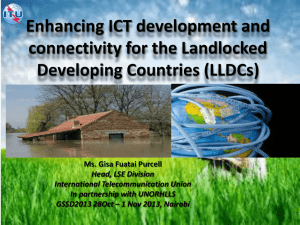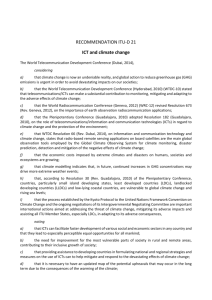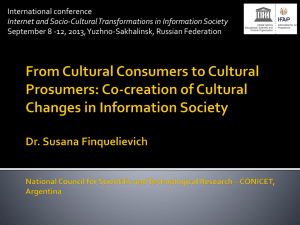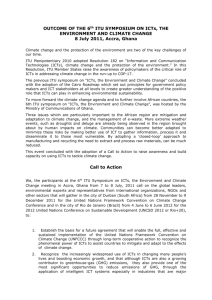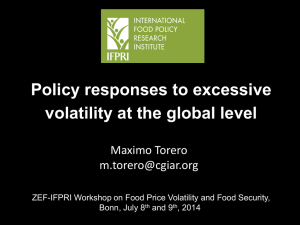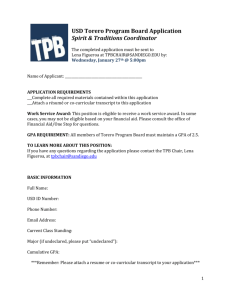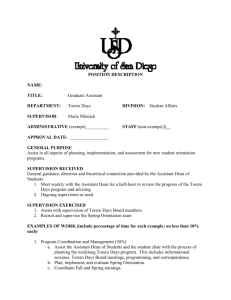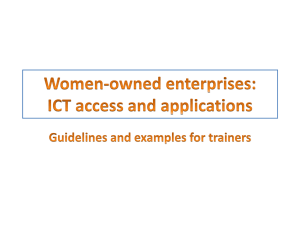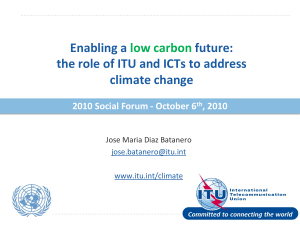Slide 1 - WordPress.com
advertisement
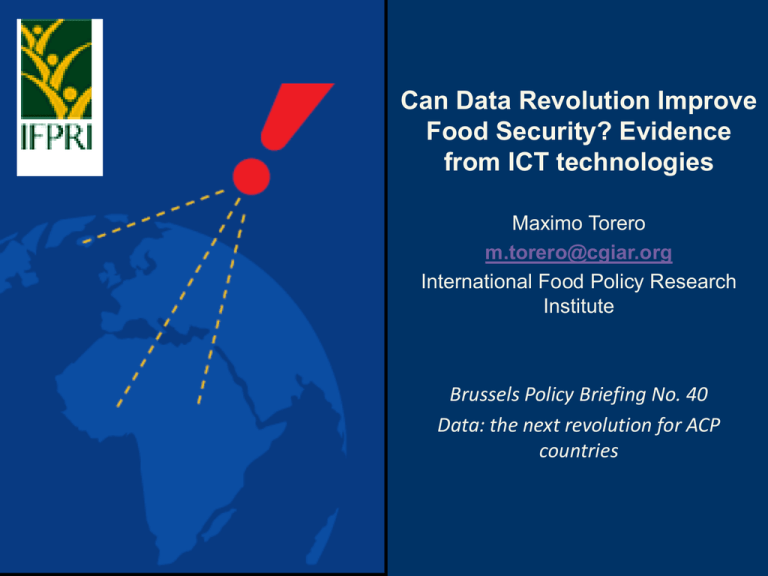
Can Data Revolution Improve Food Security? Evidence from ICT technologies Maximo Torero m.torero@cgiar.org International Food Policy Research Institute Brussels Policy Briefing No. 40 Data: the next revolution for ACP countries Example 1 Excessive volatility Page 2 Periods of Excessive Volatility 201 4 Please note Days of Excessive volatility for 2014 are through March 2014 Note: This figure shows the results of a model of the dynamic evolution of daily returns based on historical data going back to 1954 (known as the Nonparametric Extreme Quantile (NEXQ) Model). This model is then combined with extreme value theory to estimate higher-order quantiles of the return series, allowing for classification of any particular realized return (that is, effective return in the futures market) as extremely high or not. A period of time characterized by extreme price variation (volatility) is a period of time in which we observe a large number of extreme positive returns. An extreme positive return is defined to be a return that exceeds a certain pre-established threshold. This threshold is taken to be a high order (95%) conditional quantile, (i.e. a value of return that is exceeded with low probability: 5 %). One or two such returns do not necessarily indicate a period of excessive volatility. Periods of excessive volatility are identified based a statistical test applied to the number of times the extreme value occurs in a window of consecutive 60 days. . Source: Martins-Filho, Torero, and Yao 2010. See details at http://www.foodsecurityportal.org/soft-wheat-price-volatility-alert-mechanism Example 2 Global Hunger Index Page 4 Page 5 Example 3 Mobile Banking Page 6 Page 7 Connectivity Content Capability Page 8 Billions Cellular Phone subscription and Population 8 7 6 5 4 3 2 1 0 Population Cellular phones Source: Mobile phone subscriptions are from the International Telecommunication Union (ITU) and country categories are from the World Bank. Page 9 Cellular Phone subscription per 100 inhabitants in Developing Countries, by Region * 1.2 MENA 1 LAC 0.8 OECD ECA 0.6 EAP 0.4 0.2 SSA 2012 2011 2010 2009 2008 2007 2006 2005 2004 2003 2002 2001 SA 2000 0 SSA * EAP = East Asia and Pacific; ECA = Europe and Central Asia; LAC = Latin America and the Caribbean; MENA= Middle East and North Africa; SA = South Asia; and SSA = Sub-Saharan Africa. High-Income (OECD and non-OECD) are excluded from the sample. Source: Mobile phone subscriptions are from the International Telecommunication Union (ITU) and country categories are from the World Bank. Page 10 Source: Nakasone, Torero and Minten (2013). “The Power of Information: The ICT Revolution in Agricultural Development”. IFPRI. Percentage of Households that Own a Mobile Phone, by Residence Area Bolivia (2007) a/. Brazil (2009) a/. Colombia (2010) a/. Ecuador (2010) a/. Mexico (2007) a/. Peru (2010) a/. India (2011) b/. Bangladesh (2010) c/. Tanzania (2010) d/. Kenya (2010) e/. South Africa (2008 / 09) f/. Liberia (2009) g/. Malawi (2010) h/. Ghana (2010) i/. Nigeria (2009) j/. Egypt (2008) k/. Ehtiopia (2011) l/. Uganda (2011) m/. Senegal (2011) n/. Mozambique (2011) o/. Nepal (2011) p/. Zimbabwe (2011) q/. Rwanda (2010) r/. Cambodia (2010) s/. China (2010) t/. % Urban 77.6% 83.3% 90.2% 82.9% 66.6% 82.2% 76.0% 82.7% 77.5% 71.9% 87.5% 69.0% 72.7% 63.4% 88.3% 54.1% 65.2% 86.8% 95.4% 66.8% 91.6% 90.1% 71.8% 90.1% 76.3% % Rural 18.7% 53.2% 71.7% 59.7% 45.0% 47.1% 51.2% 56.8% 34.2% 55.0% 82.0% 20.7% 32.3% 29.6% 60.3% 27.8% 12.8% 53.1% 81.7% 20.0% 71.9% 48.0% 35.1% 56.2% 60.7% % All 57.0% 78.8% 86.0% 75.5% 55.2% 70.4% 59.2% 63.7% 45.4% 59.8% 85.7% 43.2% 39.0% 47.7% 70.6% 40.5% 24.7% 59.4% 88.4% 34.1% 74.7% 62.2% 40.3% 61.9% 67.9% Source: Nakasone, Torero and Minten (2013). “The Power of Information: The ICT Revolution in Agricultural Page 11 Development”. IFPRI. Comparación Internacional de los costos de una paquete básico de telefonía móvil (prepago) en 2009 US $ PPP Source: Hernan Galperin, Broadband Prices in Latin America and the Caribbean, Working Paper #15 (Buenos Aires, Argentina: Universidad de San Andrés, 2013). Notes: PPP = purchasing power parity. Prices include taxes. Equipment and connection costs are not included. The low-volume basket includes 30 outgoing calls and 33 SMSs per month. The following structure of calls is assumed: local to fixed phones (15%), national (7%), mobile in-network (48%), mobile out-of-network (22%), and voice mail (8%). The estimations assume that 48% of calls take place during peak times, 25% in off-peak times, and 27% during the weekends. The following duration of calls is assumed (in minutes): 1.5 for local and national, 1.6 for mobile on-net, 1.4 for mobile off-net, and 0.8 for voice box. The tariffs are prorated according to the market shares of each operating company. Available income for telecommunications in Brazil (5% of income) by income decile Fuente: H. Galperin, Tarifas y Brecha de Asequibilidad de los Servicios de Telefonía Móvil en América Latina y el Caribe (Lima, Peru: Diálogo Regional sobre Sociedad de la Información, 2009), 22. Note: R$ = Brazilian real. Ratio of Broadband Subscriptions to Population 0.12 ECA 0.1 EAP 0.08 0.06 LAC 0.04 MENA 2012 2011 SA 2010 2008 2007 2006 2005 2004 2003 2002 2001 0 2000 0.02 2009 SSA Page 14 Source: Nakasone, Torero and Minten (2013). “The Power of Information: The ICT Revolution in Agricultural Development”. IFPRI. Page 15 Connectivity Content Capability Page 16 ICT Impact on agriculture Extension services Market information Policy environment, laws, and regulations Natural resources and geography Page 17 Institutional arrangement for a simple price information system Source: Hernanini (2007), World PageBank 18 Flow of information and Institutional agreements for virtual markets Page 19 Source: Hernanini (2007), World Bank Have ICTs been adapted to low-income countries, and have they had an impact? • Information is an indispensable ingredient in decision making for livelihood of households. • Potential gains for rural households: • time and cost saving • more and better information, leading to better decisions and reduction of transaction costs (Stigler, 1961; Stiglitz, 1985 and 2002) • greater efficiency, productivity, and diversity(Leff, 1984; Tschang et al., 2002; Andrew et al., 2003). • lower input costs and higher output prices and information on new technologies (Gotland, et al, 2004) • expanded market reach Previous work trying to measure the consumer surplus: Saunder et al. 1983, Bresnahan, 1986, Saunders, Warford and Wellenius 1994, etc. Page 20 Results at the Micro Level Results at the Micro Level Results on extension ICT’s can also play a role in reducing the three main constraints traditional extension services: • First, poor infrastructure increases the cost of extension visits, • Second, the need to follow up information and feedback • Finally, traditional extension is plagued by principalagent and institutional problems. Aker (2011) also claims that ICTs can also make farmers better able access to private information from their own social networks. Page 23 Results on extension Fafchamps and Minten (2012) look at the effect of using SMS with crop advisory tips (offered for one crop chosen by the farmer) and local weather forecasts. They found no effect of the information for any of these outcomes. Cole and Fernando (2012) conduct an impact evaluation of the Avaaj Otalo (AO) program among cotton farmers in Gujarat, India. They find that households who benefited from AO shift their pesticides from hazardous to more effective ones. Their results also suggest that beneficiaries are more likely to harvest cumin (a high-value cash crop) Fu and Akter (2012) investigate the impact of a program called “Knowledge Help Extension Technology Initiative” (KHETI) in Madhya Pradesh, India. Those in the KHETI group increased their awareness and knowledge towards extension services, Page 24 compared to a control group. Connectivity Content Capability Page 25 Kids and ICTs for Extension • Traditional Agricultural Extension: costly, hard to reach remote areas, accountability of extension workers. • ICTs can solve many of these shortcomings. • Problem: Computer-illiterate adult population in rural areas. Agricultural extension Parents Kids Kids and ICTs for Extension: design • High School students in the northern highlands of Peru • Identified the most severe problems for farmers: blight (potato), flea beetle (potato), earworm (corn), bloating (guinea pigs), and cold (chicken). • Cost-effective and simple mechanisms. • Randomize information among students whose farms are affected by these problems. Kids and ICTs for Extension: Example (molasses trap for corn earworm Final Comments • We need significant innovation in data collection to improve access to farmers and consumers • Three C’s of ICTs: Connectivity, Capability to use it, and Content are essential • Governments need better data for proper decisions • ICTs can have an important impact in linking smallholders and SMEs to markets • Still we have a significant access gap! Page 29
